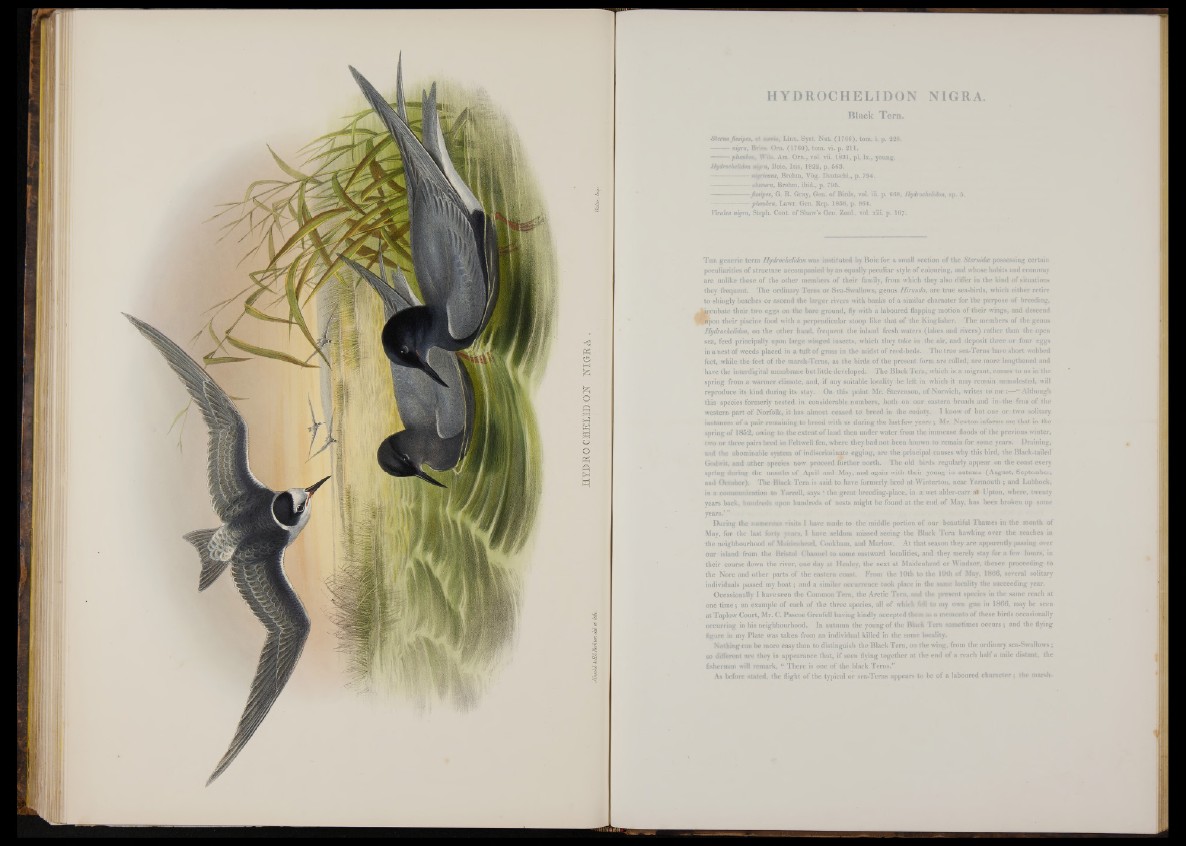
JLYDROCHELIDON I I& E 1 „
Black Tern.
Sternaßssipes, et mnu, Linn. Syst. Nat. (1766), torn. i. p. 228.
———- nigra, Briss. Orn. (1760), tom. vi. p. 211.
— «— plimhen, Wils. Am. Orn., vol. vii. 1831, pi, lx., young.
Hydrochelidon nigra, Boie, Isis, 1822, p. 563.
— nigricans, Brehm, Vög. Deutschi., p. 794.
— uhscura, Brehm, ibid., p. 795.
-------------------ßssipes, G. R. Gray, Gen. of Birds, vol. iii. p. 660, Hydrochelidon, sp. 5.
r---------- pkmbea, Lawr. Gen. Rep. 1858, p. 864.
Viralva nigra, Steph. Cont. of Shaw’s Gen. Zool., vol. xiii. p. 167.
The generic term Hydrochelidon was instituted by Boie for a small section o f the Stermdee possessing certain
peculiarities o f structure accompanied by an equally peculiar style of colouring, and whose habits and economy
are unlike those o f the other members o f their family, from which they also differ in the kind o f situations
they frequent. The ordinary Terns or Sea-Swallows, genus Hirundo, are true sea-birds, which either retire
to shingly beaches or ascend the larger rivers with banks of a similar character for the purpose o f breeding,
-incubate their two eggs on the bare ground, fly with a laboured flapping motion o f their wings, and descend
ppon their piscine food with a perpendicular stoop like that o f the Kingfisher. The members of the genus
Hydrochelidon, on the other hand, frequent the inland fresh waters (lakes and rivers) rather than the open
sea, feed principally upon large winged insects, which they take in the air, and deposit three or four eggs
in a nest o f weeds placed in a tuft o f grass in the midst o f reed-beds. The true sea-Terns have short webbed
feet, while the feet o f the marsh-Terns, as the birds o f the present form are called, are more lengthened and
have the interdigital membrane but little developed. The Black Tern, which is a migrant, comes to us in the
spring from a warmer climate, and, if any suitable locality be left in which it may remain unmolested, will
reproduce its kind during its stay. On this point Mr. Stevenson, o f Norwich, writes to me :— “ Although
this species formerly nested in considerable numbers,, both on our eastern broads and in the feus o f the
western part o f Norfolk, it has almost ceased to breed in the county. I know o f but one or two solitary
instances o f a pair remaining to breed with us during the last few years ; Mr. Newton informs me that in the
spring o f 1852, owing to the extent o f laud then under water from the immense floods o f the previous winter,
two or three pairs bred in Feltwell fen, where they had not been known to remain for some years. Draining,
and the abominable system of indiscriminate egging, are the principal causes why this bird, the Black-tailed
Godwit, and other species now proceed further north. The old birds regularly appear on the coast every
spring during the months o f April and May, and again with their young in autumn (August, September,
and October). The Black Tern is said to have formerly bred at Winterton, near Yarmouth ; and Lubbock,
in a communication to Yarrell, says ‘ the great breeding-place, in a wet alder-carr at Upton, where, twenty
years back, hundreds upon hundreds o f nests might be found at the eud o f May, has been broken up some
years.’ ”
During the numerous visits I have made to the middle portion o f our beautiful Thames in the month of
May, for the last forty years, I have seldom missed seeing the Black Tern hawking over the reaches in
the neighbourhood o f Maidenhead, Cookham, and Marlow. At that season they are apparently passing over
our island from the Bristol Channel to some eastward localities, and they merely stay for a few hours, in
their course down the river, one day at Henley, the next at Maidenhead or Windsor, thence proceeding to
the Nore and other parts of the eastern coast. From the 10th to the 19th o f May, 1866, several solitary
individuals passed my boat; and a similar occurrence took place in the same locality the succeeding year.
Occasionally I have seen the Common Tern, the Arctic Tern, ami the present species in the same reach at
one time; an example of each o f the three species, all o f which fell to my own gun in 1866, may be seen
at Taplow Court, Mr. C. Pascoe Grenfell having kindly accepted them as a memento o f these birds occasionally
occurring in his neighbourhood. In autumn the young o f the Black Tern sometimes occurs; and the flying
figure in my Plate was taken from an individual killed in the same locality.
Nothing can be more easy than to distinguish the Black Tern, on the wing, from the ordinary sea-Swallows;
so different are they in appearance that, if seen flying together at the end o f a reach half a mile distant, the
fisherman will remark, “ There is one o f the black Terns.”
As before stated, the flight o f the typical or sea-Terns appears to be of a laboured character ; the marsh